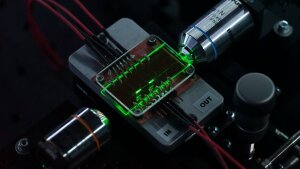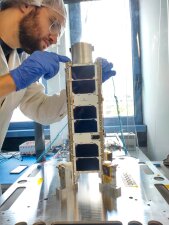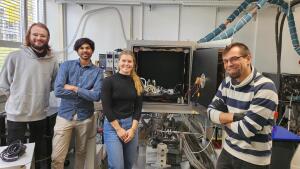
- Light
- Forschung
Published: | By: TUM, Ira Winkler
Prototype of the optical chip as used in QUICK³.
Image: Sebastian RitterAt its heart is a quantum light source based on a 2D material, being tested in a microsatellite for the first time. The Institute of Applied Physics (IAP) at Friedrich Schiller University Jena developed central components for this purpose.
At night, June 23/24, the satellite – part of an international research consortium led by Prof. Tobias Vogl (Technical University of Munich) – was launched into orbit by a carrier rocket from Vandenberg, California. First results from the mission are expected by the end of the year.
The Principle
The QUICK³ satellite is no larger than a shoebox and weighs around four kilograms. Its mission: to test components for quantum communication, enabling data to be transmitted with absolute eavesdropping security from sender to receiver. Unlike classical communication through fiber-optic cables, where information is carried by light pulses made of many photons, a quantum communication satellite sends individual, precisely defined light particles. These photons are in so-called quantum states, making the data transmission completely secure. Any attempt to eavesdrop alters the photon’s state and is instantly detectable. Since individual light particles can neither be copied nor amplified, their range in fiber optics is limited to a few hundred kilometers. Satellite-based quantum communication instead uses the unique properties of the atmosphere: in higher layers of air, light is barely scattered or absorbed – ideal conditions for secure long-distance data transmission.
To eventually use quantum communication in everyday life, several hundred satellites are needed, forming a network around the Earth. The QUICK³ mission first aims to show whether the nanosatellite’s individual components can withstand space conditions and function together successfully.
Lukas Wiese with QUICK³-Satellite during tests.
Image: Philipp WernerFlexibility and Innovation
The Institute of Applied Physics (IAP) at Friedrich Schiller University Jena was involved early in the development and integration of key components. Prof. Tobias Vogl, former head of the Integrated Quantum Systems group at IAP, emphasizes:
»At IAP, the quantum light source was developed and integrated, and the optical part of the payload (except for the laser) was built and tested. These efforts were initiated by the group led by Falk Eilenberger and continued by the research group I established there.«
This technology was developed and thoroughly tested at the Beutenberg campus in Jena – a milestone that was recognized when Prof. Vogl received the Young Scientist Award from Beutenberg Campus e.V.
Projects like QUICK³ are most successful when they bring in expertise from many researchers: together with the Technical University of Munich (TUM), the satellite was also significantly developed by scientists from the Ferdinand-Braun-Institut, Leibniz Institute for High Frequency Technology (FBH), and TU Berlin (TUB), in collaboration with international partners at the Institute for Photonics and Nanotechnologies (CNR-IFN) in Italy and the National University of Singapore (NUS).
QUICK³ Nanosatellite Uses Single-Photon Source Instead of Laser Beams
“For this mission, we are testing single-photon technology in a nanosatellite for the first time,” says Tobias Vogl, Professor of Quantum Communication System Engineering and project leader. “Currently, there’s no comparable project worldwide. Other satellites are either significantly heavier – and thus more expensive – or rely on laser-based systems, which drastically reduce data rates. Transmission speed is a major advantage of our system, as satellites have only a few minutes of line-of-sight contact with ground stations per orbit.”
Probabilities in Zero Gravity
The mission’s second goal is to test the Born rule interpretation of the wave function under microgravity conditions. This principle describes the probability of finding a quantum particle in a specific location during a measurement – a core concept in quantum mechanics. Whether this rule still holds unconditionally in space has not yet been experimentally verified.
Additional Information
- The QUICK³ mission is an international research project involving researchers from Friedrich Schiller University Jena, Humboldt University of Berlin, Technical University of Berlin, the Ferdinand-Braun-Institut, Leibniz Institute for High Frequency Technology, the Institute for Photonics and Nanotechnologies in Italy, and the National University of Singapore.
- The quantum light source was built by teams from TUM and the University of Jena and integrated with an optical chip from CNR-IFN in Italy. FBH developed a laser system to excite the quantum light source, controlled by electronics from NUS. TUB was responsible for experiment control in space and the interfaces between the payload and the satellite.
- Since July 2023, Tobias Vogl has been Professor of Quantum Communication System Engineering at the TUM School of Computation, Information and Technology.
- The project is funded by the German Federal Ministry for Economic Affairs and Energy.
Lukas Wiese, Kabilan Sripathy, Josefine Krause and Philipp Werner from the QUICK³ consortium during the qualification test. In the background is the payload in a thermal vacuum chamber.
Image: QUICK³-KonsortiumContact:
Scientific Contact:
Prof. Dr. Tobias Vogl
Technische Universität München
Professur für Quantum Communication System Engineering
tobias.vogl@tum.de
www.tum.deExternal link
Contact at the TUM Corporate Communications Center:
Julia Rinner
Pressereferentin
+49 (89) 289 – 10516
presse@tum.de
www.tum.de


